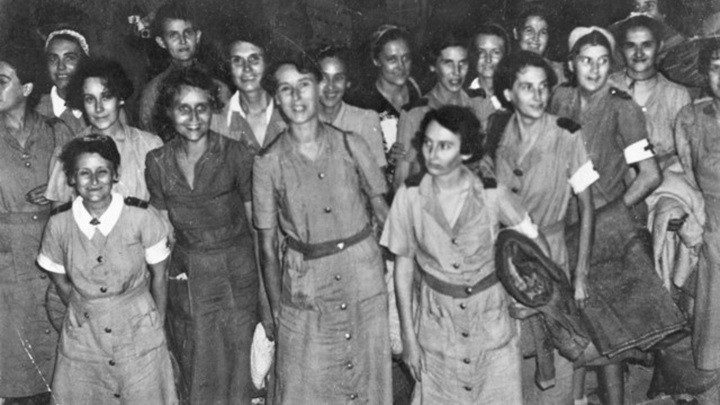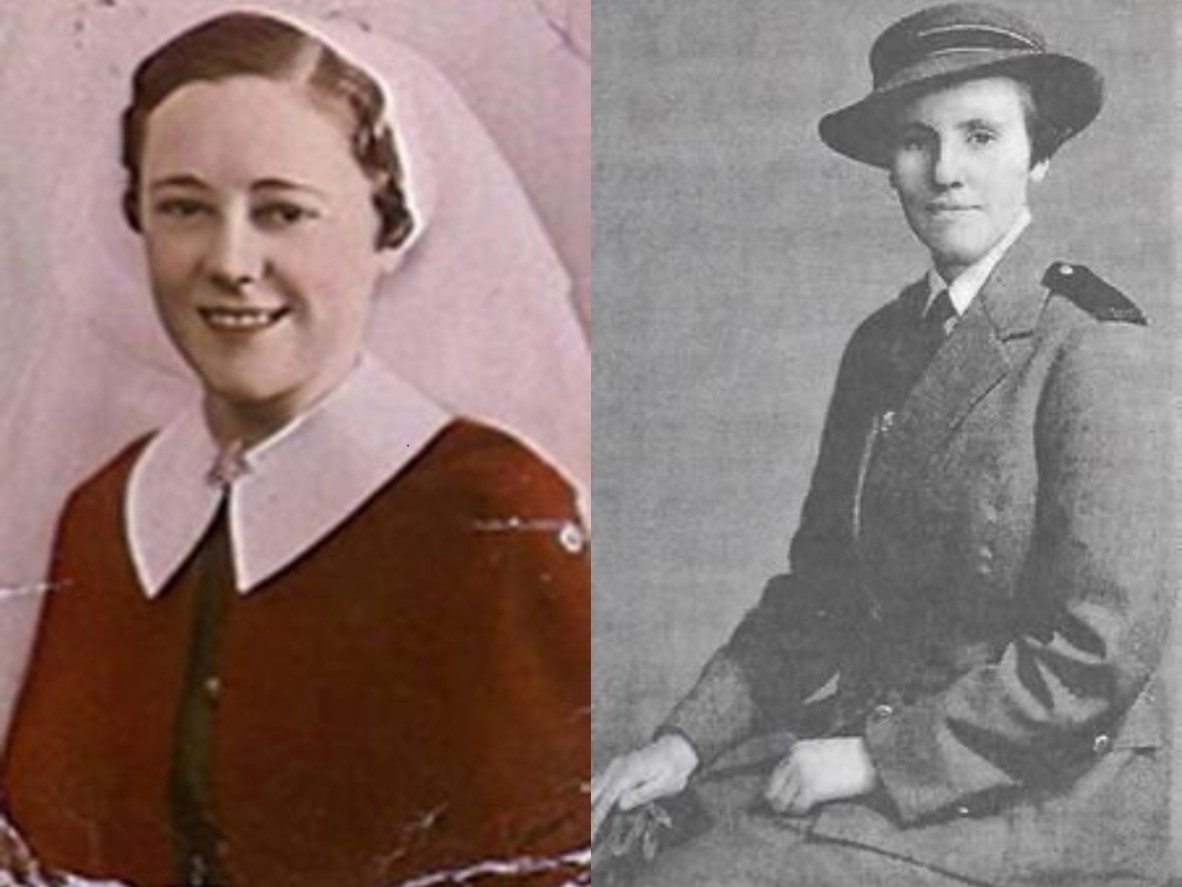Queensland Nurses on the SS Vyner Brooke
By Alaine Baldwin, Engagement Officer, Anzac Square | 14 September 2025
When the SS Vyner Brooke sailed out of Singapore on the evening of 12 February 1942, she was evacuating the last 65 nurses of the Australian Army Nursing Service (AANS) plus 52 crew and approximately 165 other passengers (patients, women and children). While the Wah Sui and Empress Star, which embarked prior to the SS Vyner Brooke, made it to Australia with the other 65 nurses who had been in Singapore this last group would not be so lucky.
By the morning of 14 February, the Vyner Brooke was approaching Bangka Strait, along the coast of Sumatra, when it was sighted by the Japanese and bombed and strafed by nine Japanese aircraft. After being hit by three bombs she sank in 20 minutes (one of 40 ships sunk by Japanese aircraft approaching Bangka Strait that day).
Of the 65 nurses on board when the ship sank twelve were born in Queensland and 3 were living and working in Brisbane when the war broke out and enlisted here.
Three of the Queensland nurses and one who enlisted here would die during the bombing and sinking of the ship.
Ellenor Calnan QX19072 from Culcairn in NSW was working as a nurse in Brisbane by 1940 and enlisted in the AANS here in 1941. It is believed she was killed during the bombing of the Vyner Brooke.
Gladys Myrtle McDonald QX22815, an only child from Brisbane, was 33 when she lost hold of the life raft she’d been clinging to and slipped under the water and drowned. She would be one of the 12 nurses who died during the bombing or in the water.
Esther Sarah Jean Stewart NX70501 from Brisbane (aged 38) and Mona Margaret Anderson Tait NX76281 from Booval (aged 27) made it ashore to Radji Beach, where the survivors lit a bonfire as a beacon for those still at sea. Twenty-one of the twenty-two nurses in this group plus most of the military and civilian men and wounded on stretchers would be massacred by a group of 20 Japanese soldiers. Sister Vivian Bullwinkel was wounded but survived to tell this dreadful story. She told Esther Stewart’s mother that her daughter’s final words were: “Girls, take it; don’t squeal!” One Bristish sailor and an American, who had been working as a brewer in Singapore, also survived.
The other Queenslanders, who survived the sinking, landed elsewhere on Bangka Island. Like Vivian they surrendered to the Japanese and became prisoners of war for the next three and a half years.
Soon after surrendering, the nurses were moved from Bangka Island to Sumatra, where they stayed for over two and a half years. They were moved back to Bangka Island in October 1944 to a camp that was already housing around 550 women and 150 children. Malaria was an acute problem there and by February 1945, 31 of the 32 nurses had it. Having survived three years as POWs, eight nurses would die between February and August 1945.
Pauline Blanch Hempsted QX22714 from Graceville, would die in the Bangka camp on 19 March 1945 from disease and malnutrition at the age of 36.
The nurses would endure one more move back to a rubber plantation in Sumatra in May 1945. It was here 41-year-old Pearl Beatrice Mittelheuser QX19068 from Bundaberg would succumb to starvation on 18 August, just days after the Japanese surrender and a day before the camp commandant handed out Red Cross parcels he’d been hoarding.

Photograph taken of the 24 surviving nurses after their release from internment, all wearing what was left of their AANS uniforms. (Australian War Memorial Collection)
The other Queensland nurses made it through and were evacuated on 11 September 1945. After a stay in hospital in Singapore they would finally embark for Australia on 5 October aboard the hospital ship Manunda.
Violet Irene McElnea QX22822, was from Ingham and would have been celebrating her 38th birthday as the Vyner Brooke left Singapore in 1942. She passed away of a heart attack, unmarried, in 1959 at Chatswood, New South Wales aged 55. She was the first of the surviving Vyner Brooke nurses to die.
Eileen Mary Ita Short QX22911 from Maryborough, returned to nursing after the war and passed away, unmarried, aged 71 years, on 25 April 1975 in Toowoomba, Queensland.
Christian Sarah Oxley QX19073 was born in Charters Towers but her family moved to Brisbane when she was about 13. She was an experienced nurse when she enlisted in January 1941. After the war she continued to work as a nurse until she married James ‘Ben’ Price in 1952. In 1953 they were delighted to welcome a daughter when Chris was nearly 41. After a long and interesting married life in the Gold Coast area Chris died in April 1994, aged 81.
Valrie (Val) Elizabeth Smith QX22819 from Cairns was mentioned in despatches in 1947 for services rendered while a POW. After the war she devoted herself to nursing. She was awarded the Australian Red Cross Society Scholarship to further her studies in England in the late 1940s. She continued to work and teach in nursing for many years. She passed away on 7 June 1995, aged 83.

Cecilia May Delforce (Australian War Memorial portrait photo) and Joyce Tweddell (The Telegraph, Brisbane Monday 22 March 1943)
Joyce (Tweedie) Tweddell QX19070 was born in Brisbane and went to Petrie Terrace State School and Brisbane State High School. She studied nursing when she turned 18 and was working at Brisbane General Hospital (RBH) prior to joining the AANS in January 1941. After her years as a POW, she spent nearly eight months in the Margate Convalescent Home upon her return to Australia in October 1945. Returning to work as a nurse, she was employed by the Brisbane General Hospital as second in charge of radiography. She remained at the RBH until she retired in 1979 as Queensland’s Chief Radiographer. In 1993 Joyce was part of the group of seven survivors who returned to Bangka to dedicate a memorial on Radji Beach. The Joyce Tweddell Building at RBH honours her lifelong dedication to nursing and radiography. Joyce died in Caloundra in 1995, aged 79.
Sylvia Jesse Mimmi Muir QX22816 from Longreach, married fellow ex POW Collin McGregor after the war. They first met when she was nursing in Malaysia in 1941. Although they married in Brisbane, they operated a dairy farm in Bega and raised their three sons there. Sylvia returned to Brisbane after Collin’s death and remained here until her death in 1996, aged 80.
Jessie Jane Blanch QX19074 from Bangalow NSW was working at the Brisbane General Hospital (RBH) when she enlisted in January 1941. She was awarded the Associate Royal Red Cross in 1947 for 'service attending wounded in POW camps'. In 1950, aged 40, she married Albert Eaton-Lee. She was 89 when she passed away in Alstonville, NSW in 1999.
Florence ‘Flo’ Elizabeth Trotter QX19077 was born in Eastwood NSW but the family moved to Brisbane when she was about 9. She trained at the Brisbane General Hospital and was working there when she enlisted in 1941. After the sinking of the Vyner Booke she drifted for 18 hours before reaching shore and joining the other survivors as a POW. She was a member of the amazing choir that started in the camp and helped boost morale. She was Mentioned in Despatches in 1947. That same year she married fellow survivor Ada Syer’s brother, Frank. They had 2 daughters, but Frank died in 1959. Flo went to work as an Internal Staff Nurse with Allan and Stark department store, retiring in 1976. The Florence Syer Ward at Greenslopes Private Hospital was named in her honour in 1999. After an extraordinary life, she died in Brisbane in July 2002 aged 86
Cecilia May Delforce QX19071 from Augathella, was also mentioned in Despatches in 1947 for her service while a POW. After the war, in 1946, she married a fellow POW, Allen McPhee. They raised their two sons in Wollongong before retiring to Broadbeach Waters on the Gold Coast. She was the last of the Vyner Brooke survivors when she died in 2011 at the age of 98. She asked that no flowers be placed on her grave as her friends who died in 1942 had had no flowers.
These brave and dedicated women experienced unbelievable wartime trauma and deprivation. They lost good friends and colleagues while battling disease and starvation. However, their close bonds and sense of humour helped sustain them. For the rest of their lives, they would periodically catch up with their old Queensland ex-POW comrades at numerous reunions, weddings and casual get-togethers.
We honour them by remembering their bravery and sacrifice.
Further Reading:
Trove articles
https://trove.nla.gov.au/newspaper/article/50270121?searchTerm=Esther%20Sarah%20Stewart
https://trove.nla.gov.au/newspaper/article/136449617?searchTerm=cecilia%20May%20Delforce
https://trove.nla.gov.au/newspaper/article/212778585?searchTerm=Violet%20McElnea
https://trove.nla.gov.au/newspaper/article/49924765?searchTerm=Pearl%20Mittelheuser
https://trove.nla.gov.au/newspaper/article/188766664?searchTerm=Sylvia%20Jessie%20Muir
https://trove.nla.gov.au/newspaper/article/188755115?searchTerm=POW%20nurses%20freed
Comments
Your email address will not be published.
We welcome relevant, respectful comments.